Once again about Trajan’s column as a historical source
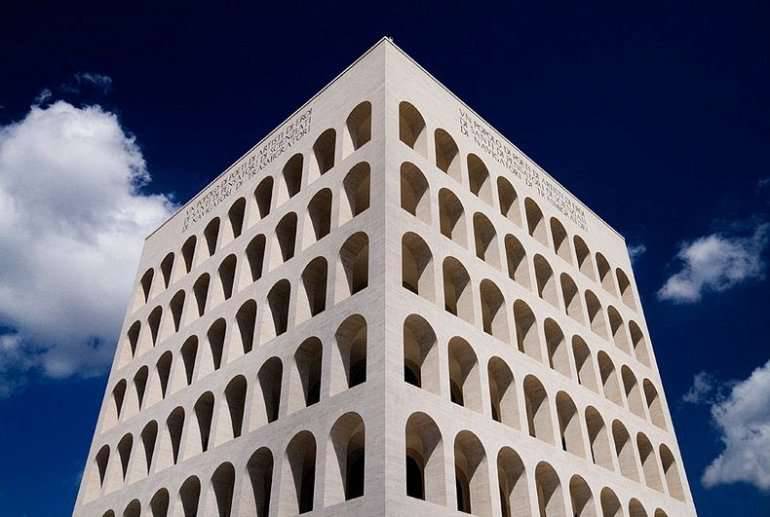
Here it is - "Square Colosseum"
In the material on the pages of the All-Russia Public Association “Do not trust your eyes or the column of Emperor Trajan as a reliable historical source” (http://topwar.ru/73172-.html) this monument has already been considered. However, this topic is so interesting that it makes sense, without repeating, to return to it again, taking into account the new information. And you have to start ... with a wish in one of the comments to keep this interesting monument. Here is what was written there: silver169 “Such a most valuable, unique historical sample of the late Roman period must be kept in a closed pavilion. Recall what happened to the world-famous sculpture by Michelangelo "David", which for a long time was under the open sky and was very affected by the effects of precipitation and weathering. In the end, the sculpture was forced to move inside the Florentine Academy of Fine Arts. But it happened in the distant 1873 year. In our time, precipitation is a real acid that destroys marble. It is a pity if the carving on the column of Troyan will die. After all, this is a historical heritage not only of Italy, but of the entire cultural world. ”
Initially, the column was not intended to be white. Her figures were to be painted in different colors, and in the hands of her characters was supposed to be a miniature bronze weapon!
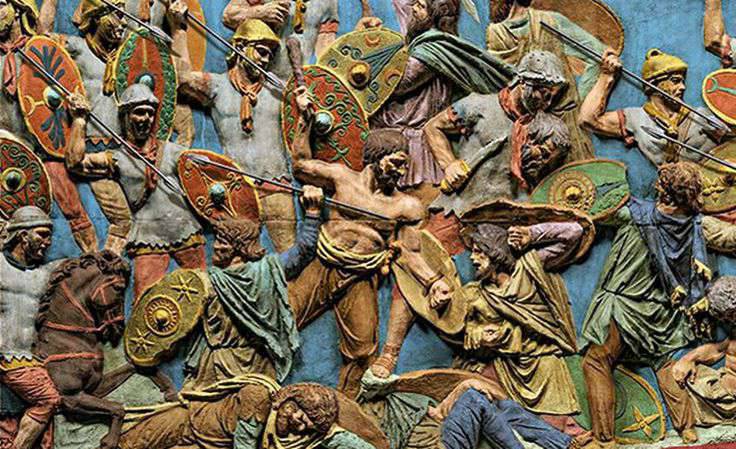
This is how it should look like in the original!
It is quite logical, isn't it? But ... to disassemble the column and transport it somewhere, or on the contrary - to hide it inside the glass column-case ... Of course, the problem with its safety will have to be solved very soon. But, the Italians still made sure that, at least, copies of all its remarkable bas-reliefs would be kept under the roof and in no way exposed to the weather. So now, if you find yourself in Rome and want to carefully examine all of its remarkable bas-reliefs, you will not need either binoculars or quadrocopters. You can just get in a taxi and say: “Universite Romana” and you will be taken there, the benefit is just 20 minutes from Rome. There you will immediately see the building of fantastic architecture. Very similar to the Colosseum, however white and cubic in shape! It was built by dictator Benito Mussolini as a pavilion for the 1942 world exhibition of the year, and to adequately celebrate the twentieth anniversary of fascism invented by him and the beginning of the Fascist era. Because of the war, the exhibition never took place, and Mussolini was overthrown on 1943. And this very “palace of fascism”, the Colosseo Quadrato or Square Colosseum, was turned into the Palace of Italian civilization (Palazzo della Civilta Italiana). Like the Colosseum, its facades consist of loggias, arranged in six rows of nine arches each. Italians are sure that all this is equal to the number of letters in the name “Benito”, and, accordingly, in the name “Mussolini”.
The inscription on the pedestal.
The palace is covered with marble. Its base occupies 8,400 square meters, and the entire volume of the building is equal to 205,000 cubic meters with a height equal to 68 meters. Sculptures of the Dioscuri are set at the four corners. Well, as for the column of Trajan, this building is now connected with it in the most inseparable way: it has plaster casts of all its bas-reliefs, but there is a developed “plaster cloth” in length of 190 meters. All the impressions were made with the help of the Vixint matrices, thus, an exact copy of all the reliefs of the column was created in the form in which they are today, that is, with all the existing damage. And, of course, it was done more than timely, as the state of the column continuously deteriorates - automobile exhaust gases cause irreparable damage to it. Proved over the past 50 years, it has deteriorated more than in all previous 1850 years. In addition, it begins to gradually deviate from its vertical position, and no one knows how to deal with this. Besides, it is very difficult to fix it. After all, the column was built without the use of fastening solution. All its blocks are connected by iron or copper clamps, and those in turn are filled with lead, and the clamps themselves are in the thickness of the blocks.
The column stands on a plinth pedestal, decorated with bas-reliefs depicting Dacian trophies. The following items are written on it: "SENATVS POPVLVSQVE ROMANVS IMP. CAESARI DIVI NERVAE F. NERVAE TRAIANO AVG. GERM. DACICO PONTIF. MAXIMO TRIB. POT. XVII IMP. VI COS VI PP AD DECLARANDVMVPVPVTs IVPVTVVPV.PVVI ROMANVS POPVLVSQVE ROMANVS IMP. "-" the Senate and the Roman people [erected this column] Emperor Caesar Nerva Trajan Augustus, son of the divine Nerva, Germanic, Dacian, great pontiff, tribune of the people in positions of authority in 17-th time, the Emperor in 6-th time, the Consul in 6- the first time, Father of the Fatherland, in order to make it clear how tall the hill was, to make room for the construction of such significant structures. " It is known that the fakes in marble do not work out, so the subverters of the foundations regarding the antiquity of this monument need not worry - to question its antiquity anyway, that to doubt that the Sun rises in the East.
Staircase leading inside the column.
It is known that there were two wars with the Dacians: 101 - 102. BC; 105 - 106 AD The last war ended with the accession of Dacia to the Roman Empire. Well, now we come to the main point: what can we see on the bas-reliefs of the Trajan column, if we carefully examine them almost closely.
So, the protective armor of the Romans: there are only three. Roman legionaries are wearing lorica segmentata lamellar armor made of curved and metal stripes facing each other; Auxilarians (auxiliary troops) wear lorica hamata chain mail; Well, among the archers, many in scaly armor lorica scuamata.
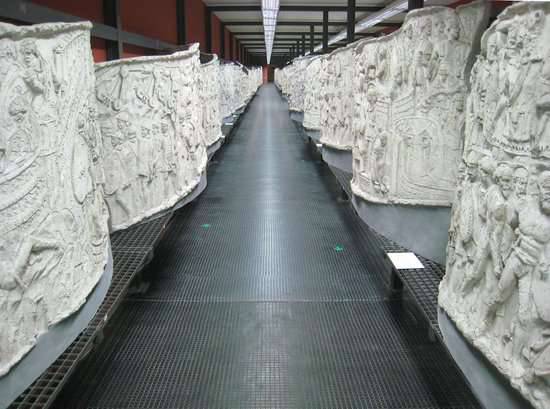
Here is the room with copies of the bas-reliefs of the column.
The reliefs of the column of Traian convincingly prove that the eastern warriors could wear several types of armor at once. Over their long, down to almost toes tops, they could have a chain mail shirt with short sleeves of the “Lorik Hamata” type, and a carapace made of metal scales of the “Lorica Skumat” type. According to Michael Simkins, the advantage was still given to the chain mail, as it was more comfortable in battle and less constrained by the movements of the eastern shooter, although scaly armor was superior to chain mail in strength. Well, in order that neither metal scales, nor rings rub their necks, the warriors usually tied it with a scarf.
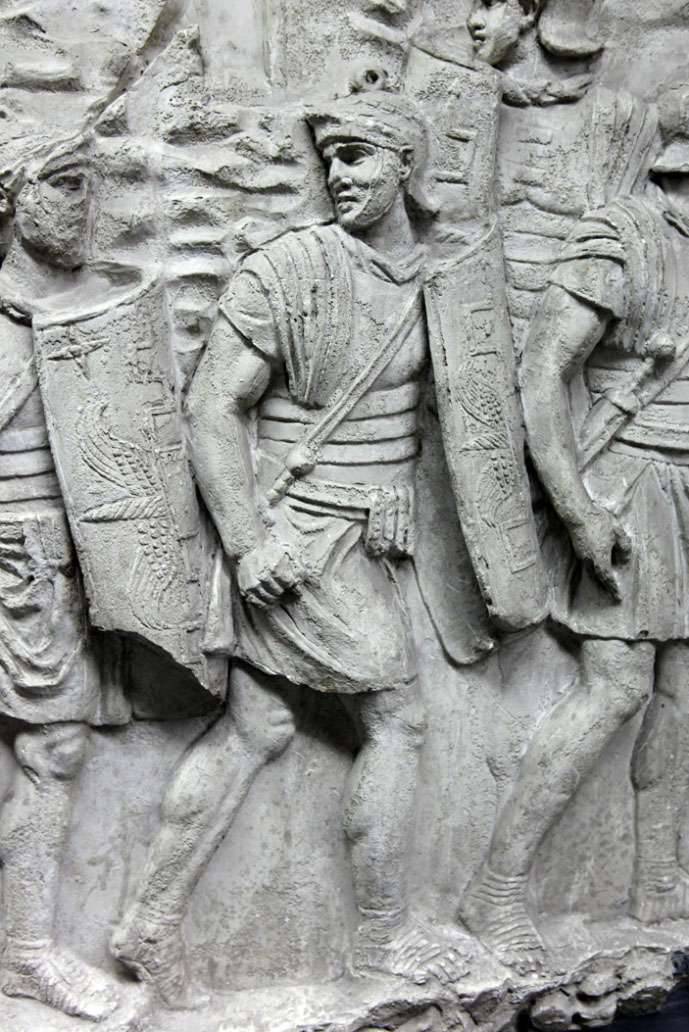
Legionnaires in the campaign.
Epigraphic sources indicate that most of the eastern support units that fought in Moesia and Dacia consisted precisely of archers armed with composite bows. Their importance in the Roman army during the first two centuries of the new era increased all the time and reached its apogee in the 3rd c. AD So no invasion of the Huns and ready nothing to do with it. Especially prized archers from Palmyra. They had excellent composite, characteristic only for the eastern peoples, bows, their fighting qualities different from all others.
Syrian archers and German slingers.
Almost all the specialists who studied the military affairs of ancient Rome note both the power and the range of this type of weapon. A heavy military arrow fired from it flew on the 150-200 m, and the light one was twice as far. This bow was much shorter than the English long bow. It was made of wood, and for greater strength it was strengthened on the inner side of the bend with horn plates, and outside with tendons. The penetrating power of the weapon was increased, strengthening the ends of the bow with horn tips. The shooter had from 12 to 24 arrows that were kept in fire (on fire - wooden case for bows and arrows; separate case for bows - on beam or sided, case for arrows or bolts - quiver; sided, also used as a synonym for fire ), which was worn on a belt thrown over the right shoulder, on the back. In the arsenal of sagittary, that is, the archer, there was also a Roman-style sword, which he, like the usual infantryman, wore in a sheath on his right side.
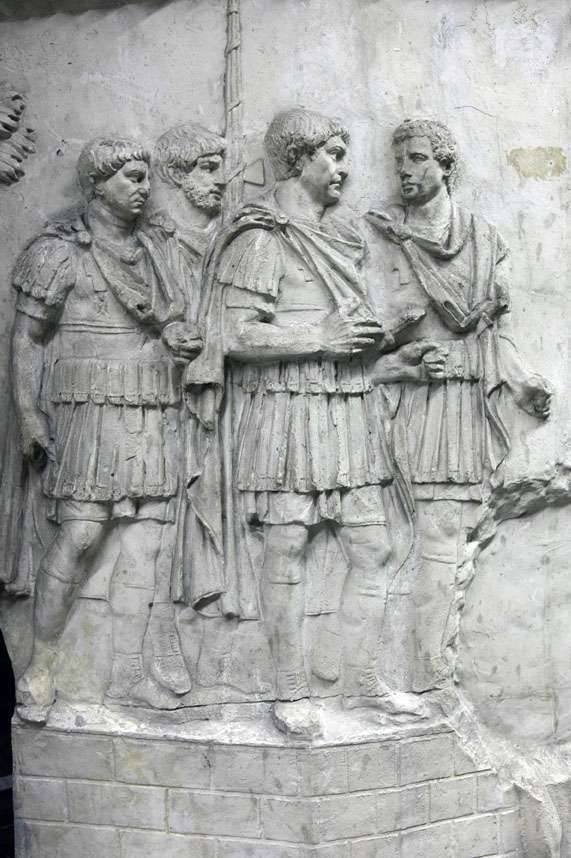
Note the flat circle on the right and below the emperor figure. It is nothing more than a closed hole, which the “metal hunters” made to extract the brackets holding the marble drums of the column. It turns out that the entire Colosseum is exactly in the same holes.
The Wikipedia article "Romfey" states that the Dacians used something like Romfey, but only their weapons were called falx. The main difference between them was the bending of their blades: in Romfey, it was straight or slightly curved, but in a falx the blade was curved very strongly. Pay attention to the damage caused to the bas-reliefs by nature - the impression is that the bas-reliefs were gnawing at the mouse!
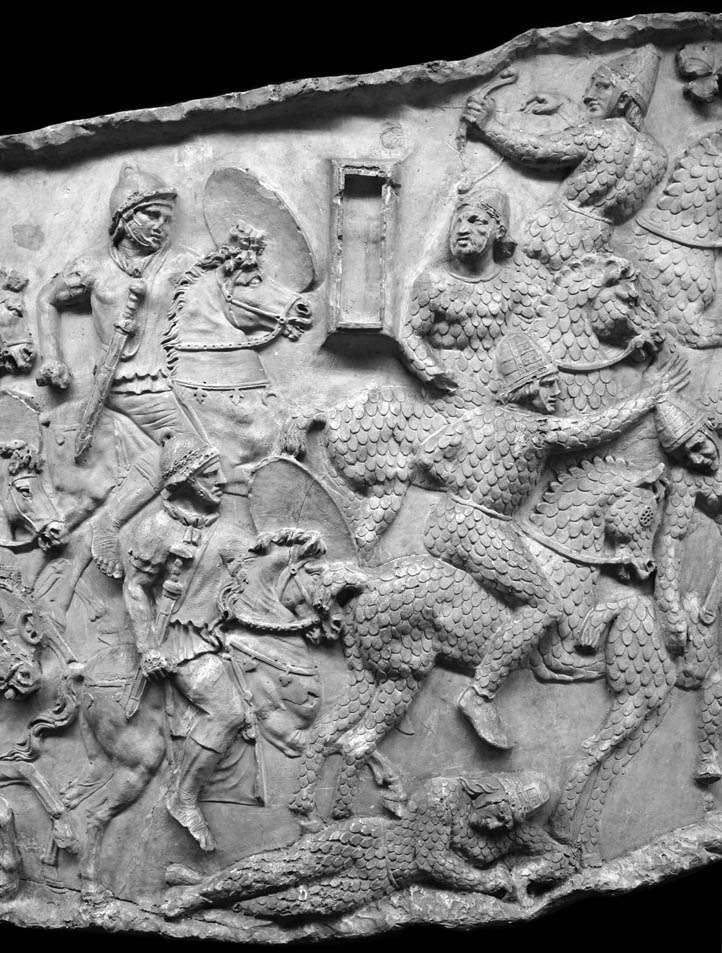
The Dacian allies in this war were Sarmatians who supplied cavalry to the Dacians, and this is what Tacitus writes about: the Sarmatian leaders and noble warriors have so heavy armor that a warrior who fell from his horse can barely get back on his feet without help. And also “that their spears and swords are so long that they have to be held with both hands”.
As noted in the previous article, a number of surprising contradictions are clearly visible on the column. Thus, in running Sarmatian horsemen, the scales covered not only themselves, but also their horses, and even their tails! Here we see the Sarmatian armor in the form of trophies - these are normal, scaly shells of shirt-cut, known from archaeological finds.
Sarmatian trophies.
What is this incompetence of the sculptor or an evil satire? Alas, but to prove both of these assertions is not possible today. In addition, many Roman riders or auxiliaries' legionnaires have very short chain mails with a scalloped hem. The Syrian archers are very long, whereas the Romans are too short, so they don’t even close the “most important”. And besides, the Romans - all, without exception, very small shields.
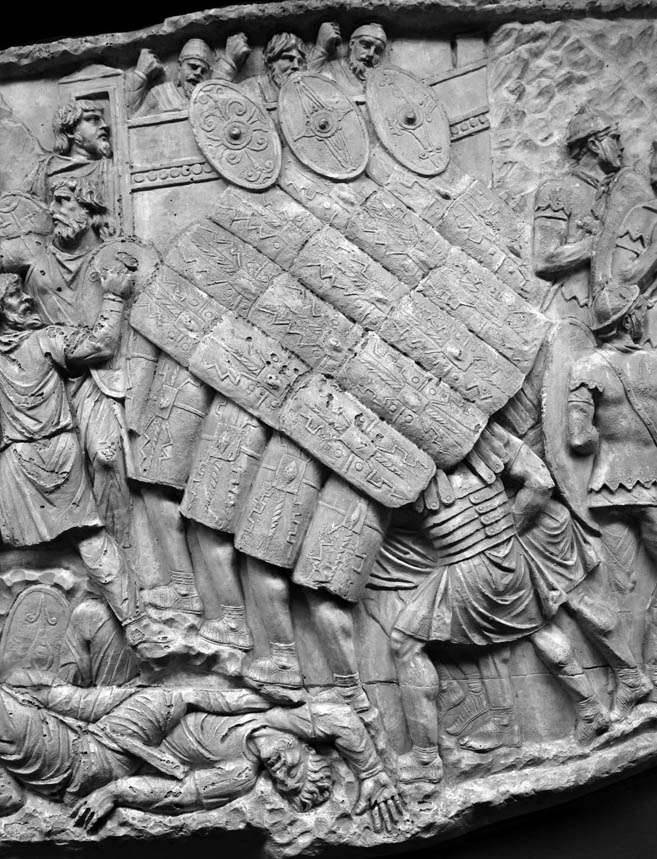
From such small shields a decent "turtle" can not be built!
Analyzing the frequency of the image of flat oval shields of warriors on a column and tile-like rectangular scutums, we can make an amazing conclusion that the first are more than 80%, and the second for some reason are very few and if we know exactly who the shields of the Romans at that time were ... Who then fought in Dacia? It turns out that the bulk of the Roman troops already consisted of mercenaries — auxiliaries, eastern archers, and German slingers, and there were very few of the legionnaires among them!
One might think that there was mostly dismounted cavalry that was known to be the main unit of the 500 man (ala quingenaria), which consisted of 16 rides around the 30 riders. It is believed that the imperfection of the Roman cavalry is due to the imperfection of the horse harness. They had neither stirrups nor saddles, instead of which on each horse there were two blankets (go chaprak), lower and upper, made of cloth, leather or fur, reinforced with a belt girth, as well as a breastplate and braggart. The lower blanket was longer and wider, sometimes with a fringe along the edge, and the upper one was shorter and narrower, with festoons along the lower edge. Both blankets were connected using ribbons, buttons or straps. The bib and harpover were decorated with metal plates in the form of crescents, chased discs and flat flower buds. A bridle with two reins and headbands with decorations was used to control the horse. Here, on a horse “dressed” in all this, the Roman horseman was sitting with a shield on his left hand, holding in it the reins, but in the right spear or sword. To control the horse had to reins and Shenkeli, but to fight and control the horse in the presence of such a harness was quite difficult, especially since the Romans themselves were by nature rather infantry than riders.
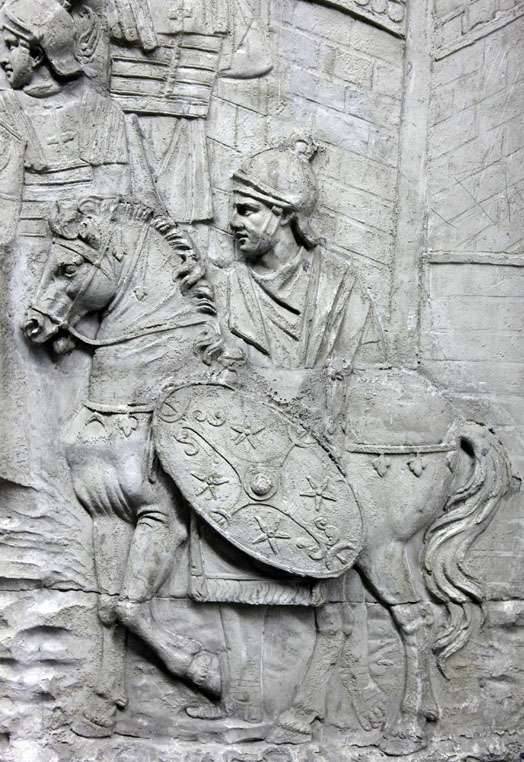
Roman rider from the column of Trajan.
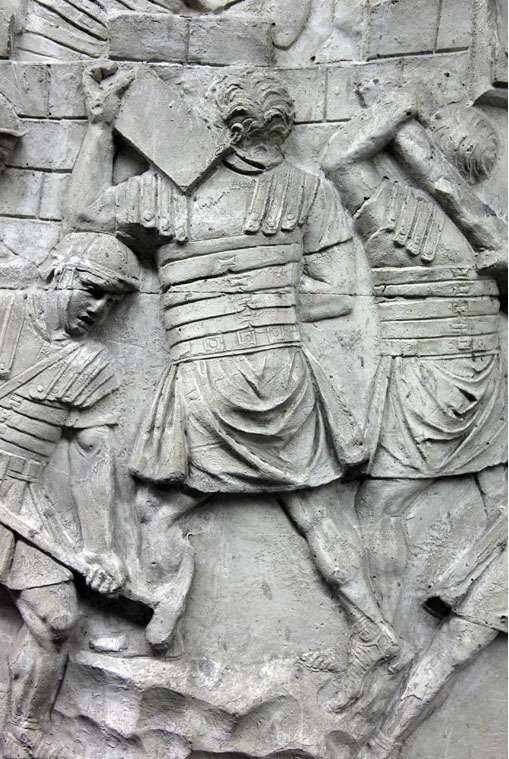
A stone block of this size will be too heavy to be lifted up and carried on your shoulder so easily. And either it is an earthen block, or another liberty of the artist, thus demonstrating the power of the Roman soldiers.
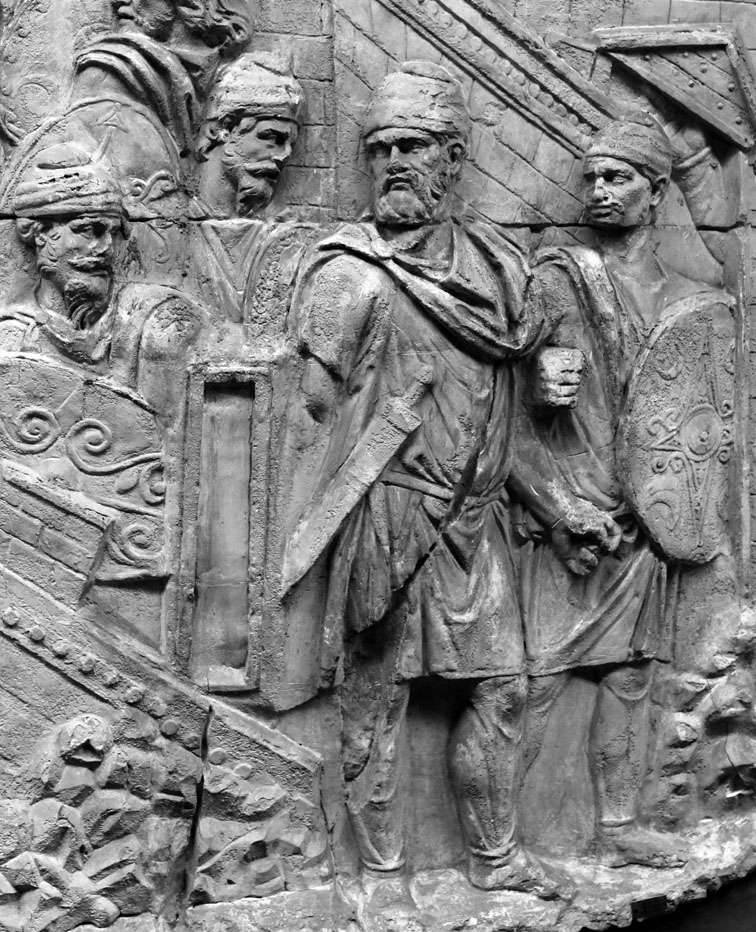
Decebal in a typical Dacian helmet and with a long sword. Everything is just the same as in the movie "Duck".
Dion Cassius writes that the head and the right hand of Detsebal (this is also mentioned in the well-known films “Dacia” and “Column”) was presented to Traian, located in the Rannisstorum fortress, whose location is unknown. In 1965, during the excavations near the city of Philippi in Macedonia, archeologists found a tombstone of the explorator (exploratores - reconnaissance) of the Second Pannonian aber of Tiberius Claudius Maximus. The inscription on it informs that it was he who managed to seize the body of the Dacian king, and then delivered the bloody trophy to his emperor. First, the head of Detsebal was put on a platter in the middle of the Roman camp, and then sent to Rome, where she was thrown from the Hemonium Terrace into the Tiber. So the credibility of the scenes depicted on the column is very great, but as for the details of military equipment, the questions still remain!
“And in the Pacific Ocean, we finished our campaign!” At the left, at the very top, the Dacians leave Dacia and take the cattle with them.
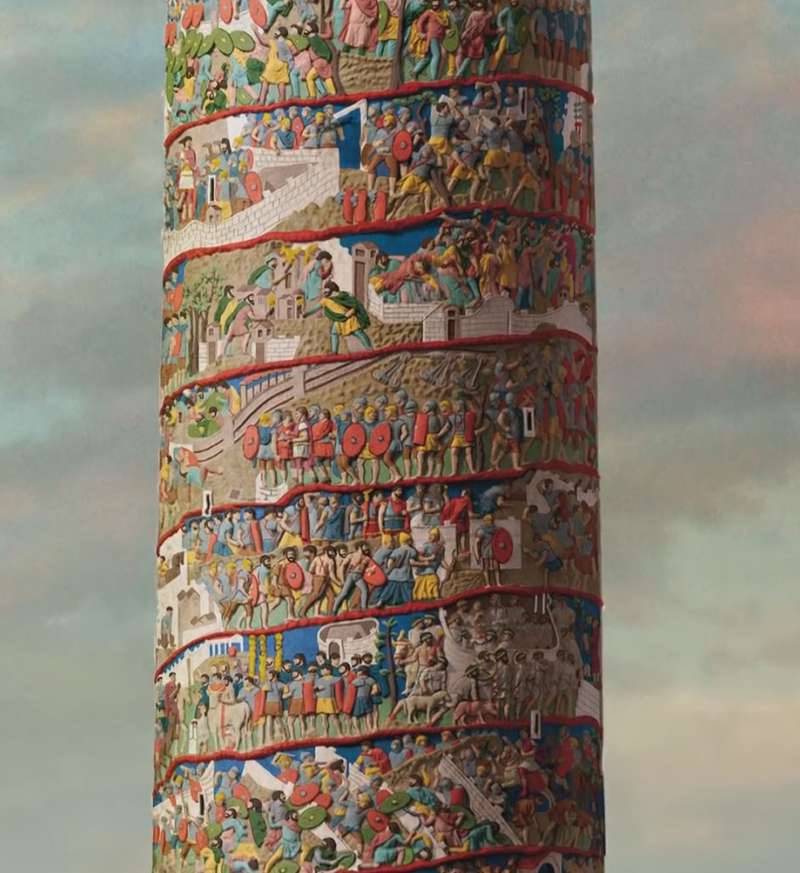
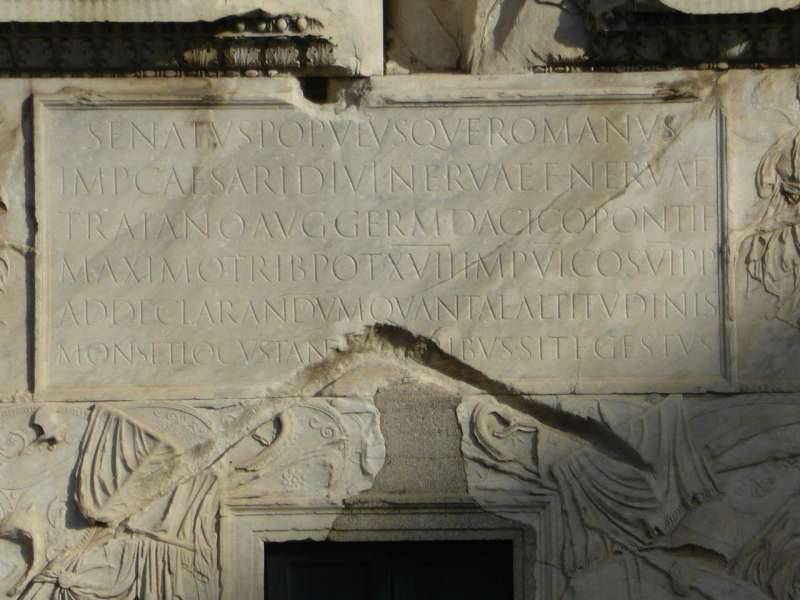
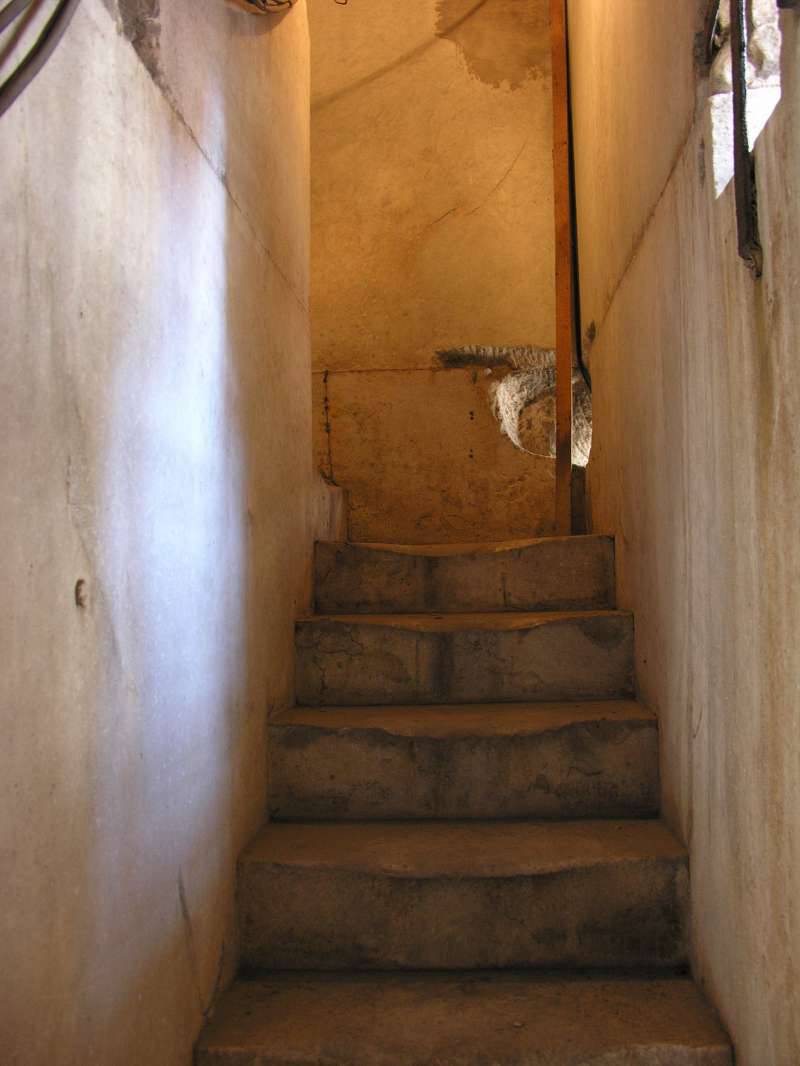
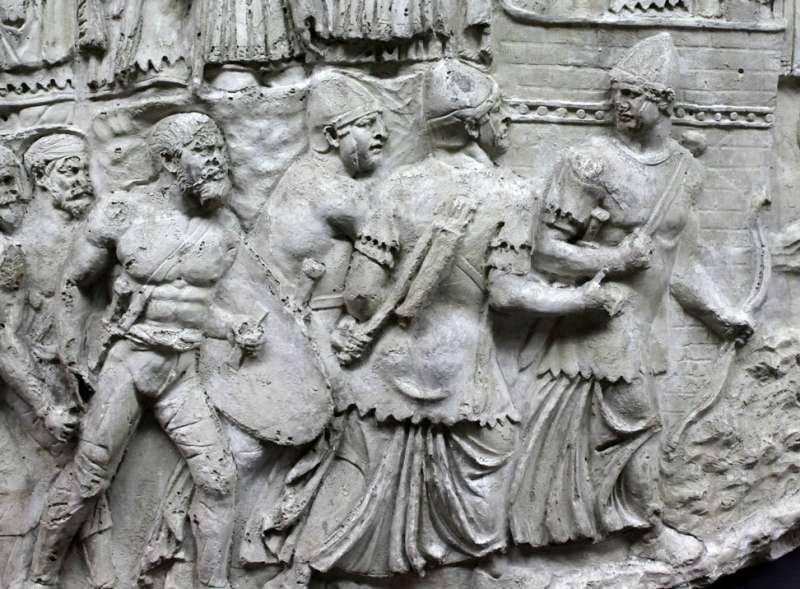
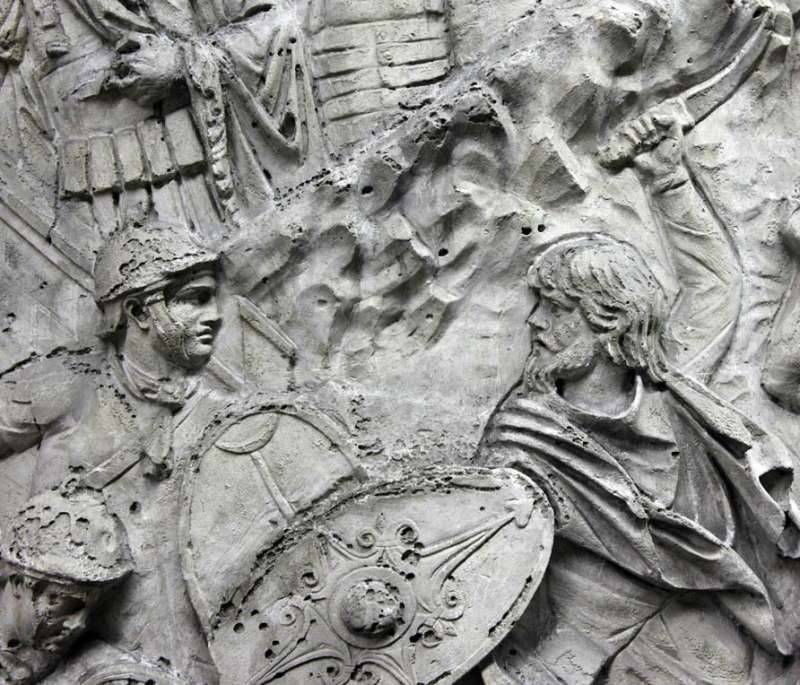
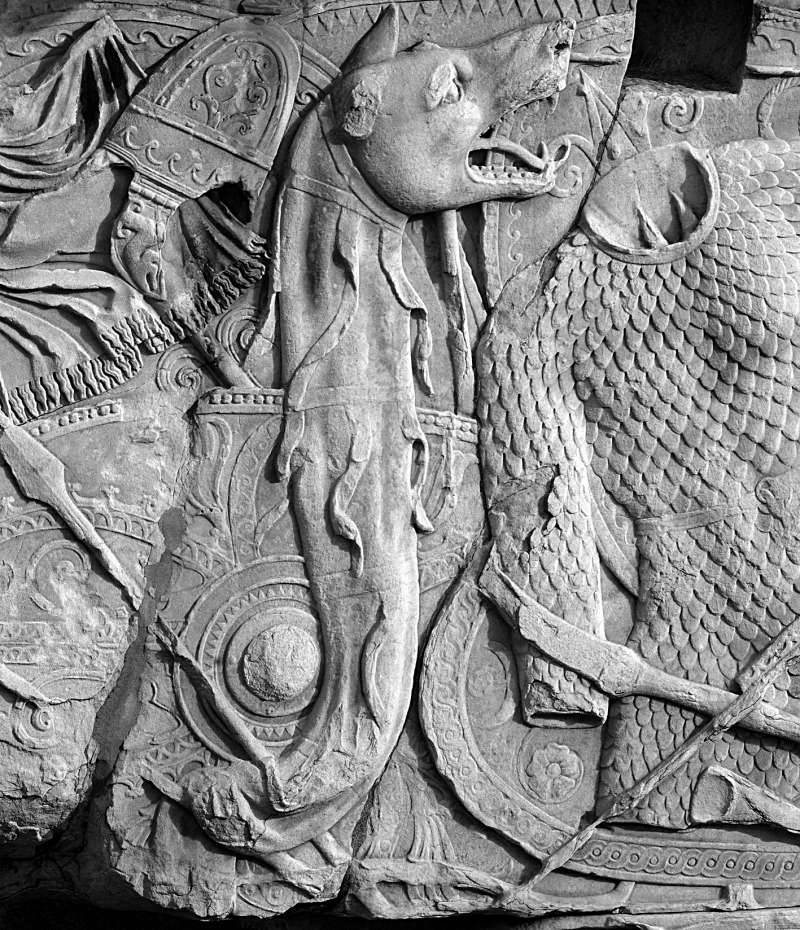
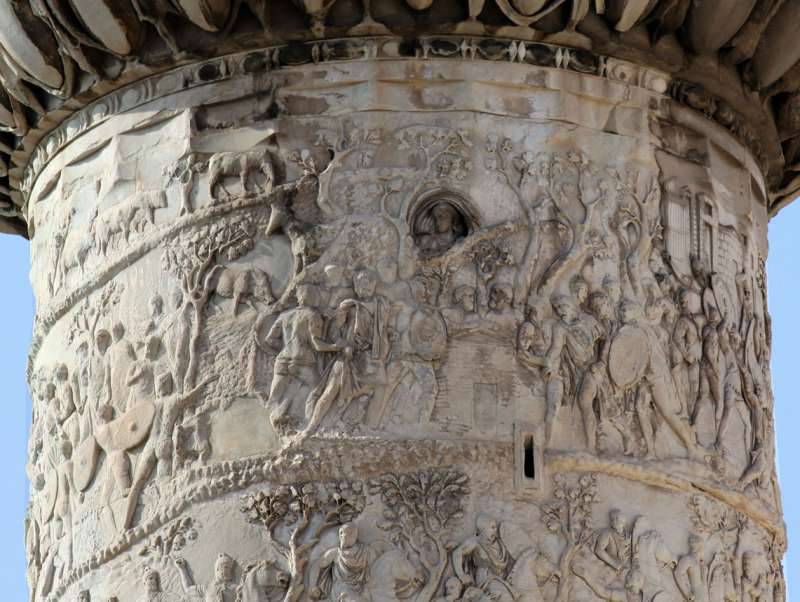
Information